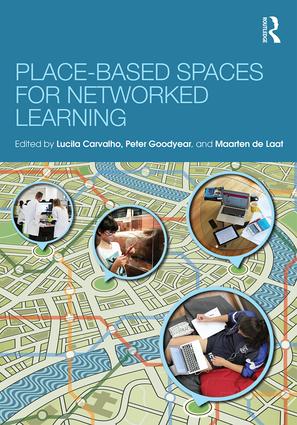Sian Bayne, James Lamb, and I have a chapter in the new book Place-based Spaces for Networked Learning edited by Lucila Carvalho, Peter Goodyear and Maarten de Laat. The chapter is on the sound spaces of online, distance learners drawing on data from the University of Edinburgh’s research project “New Geographies of Learning: distance education and being ‘at’ the University of Edinburgh.”
Borrowing from the chapter itself:
“The growing influence of the digital within higher education prompts us to rethink how and where learning takes place. Conventional understandings of the university, with its lecture theatres, seminar rooms and social areas, are problematised by the varied and fluid learning spaces of online students who may never cross the threshold of the physical campus. Much has been written about the digital environments where online learning takes place, however up to this point relatively little attention has been paid to the material spaces that online distance students occupy while learning.
There are some notable exceptions to this. Kirkwood (2000), for example, explores the complexity and diversity of the domestic context for online students – a complexity which in turn impacts the use of technology and the educational process itself – while Kahu, Stephens, Zepke & Leach (2014) interrogate the role of space and time in shaping the study practices of mature online students. Of particular interest to the research presented in this chapter is Kahu et al’s presentation of student engagement in online education as a complex aggregation of factors, of which access to and control over domestic space is one. Additionally, Moss’s (2004) concepts of time and space as qualitative entities and their role in creating space for learning has resonances for the work described here.
In this chapter we describe and discuss how we used a combination of aural, textual and visual data to gain insights into the learning spaces of online distance students. In particular, we were interested in the sonic and material components of student study spaces. Our focus on ‘space’ is influenced by the Mol and Law’s (1994, 2001) work on social topology, and on the ‘spatial turn’ in social science research identified by Fenwick et al (2011), which draws into question the assumption that space functions as a ‘static container’ (129) within which individuals act. Rather, space is seen as a dynamic entity which is produced by the social and material interactions which take place ‘within’ it.
Our work here builds on earlier research where we explored the social topologies of distance students (Bayne et al, 2013) and the construction of ‘nearness’ for distance students to their affiliated university (Ross et al, 2013). Using data generated from our earlier research, this chapter suggests that the construction of student study space often has to be negotiated from within domestic space, and doing so involves the deliberate use of manufactured silence or sound in order to establish territories for personal learning.
Our research found that for every considered and composed construction of visual study space (neatly arranged laptop, notebook, and pens), we saw contested aural space (streets, cars, and horns; children and TV playing cartoons in the background). It also suggests that the practices that these distance students developed to create study space all involved varying degrees of territorialism (Fluegge, 2011). From a methodological perspective, therefore, we highlight the value of a multimodal approach, arguing in particular for greater attention to the use of aural data in helping us to understand the construction of space, including its interaction with the visual. Aurality is currently neglected within the educational literature, an absence that we have started to address here.”
So, and there certainly might be more, the following research outputs have emerged from the “New Geographies of Learning: distance education and being ‘at’ the University of Edinburgh“, a project of which I was most fortunate/lucky to be a member.
- Bayne, S., Gallagher, M. and Lamb, J. (2013) Being ‘at’ University: the social topologies of distance students. Higher Education. DOI: 10.1007/s10734-013-9662-4
- Ross, J., Gallagher, M. and Macleod, H. (2013). Making distance visible: assembling nearness in an online distance learning programme. International Review of Research in Online and Distance Learning, 14/4. http://www.irrodl.org/index.php/irrodl/article/view/1545
- Gallagher, M.; Lamb, J. & Bayne, S. (2017). The sound spaces of online, distance learners. In Place-based Spaces for Networked Learning book (eds. Lucila Carvalho, Peter Goodyear and Maarten de Laat). Sydney: Routledge.

“New Chapter: The Sound Spaces of Online Learners from Place-Based Spaces for Networked Learning” https://t.co/7zmfVbw4wk #education
The Sound Spaces of Online Learners, new chapter from @sbayne, @james858499 & me. https://t.co/n2k2WF9nT9 #mscde https://t.co/jp9PYAOBYL
RT @mseangallagher: The Sound Spaces of Online Learners, new chapter from @sbayne, @james858499 & me. https://t.co/n2k2WF9nT9 #mscde https:…
The Sound Spaces of Online Learners from Place-Based Spaces for Networked Learning https://t.co/3glViGEXF2… https://t.co/AtLlaF8TF0
The Sound Spaces of Online Learners from Place-Based Spaces for #NetworkedLearning https://t.co/IK1aZ0hTja… https://t.co/VTmIBcrdp8